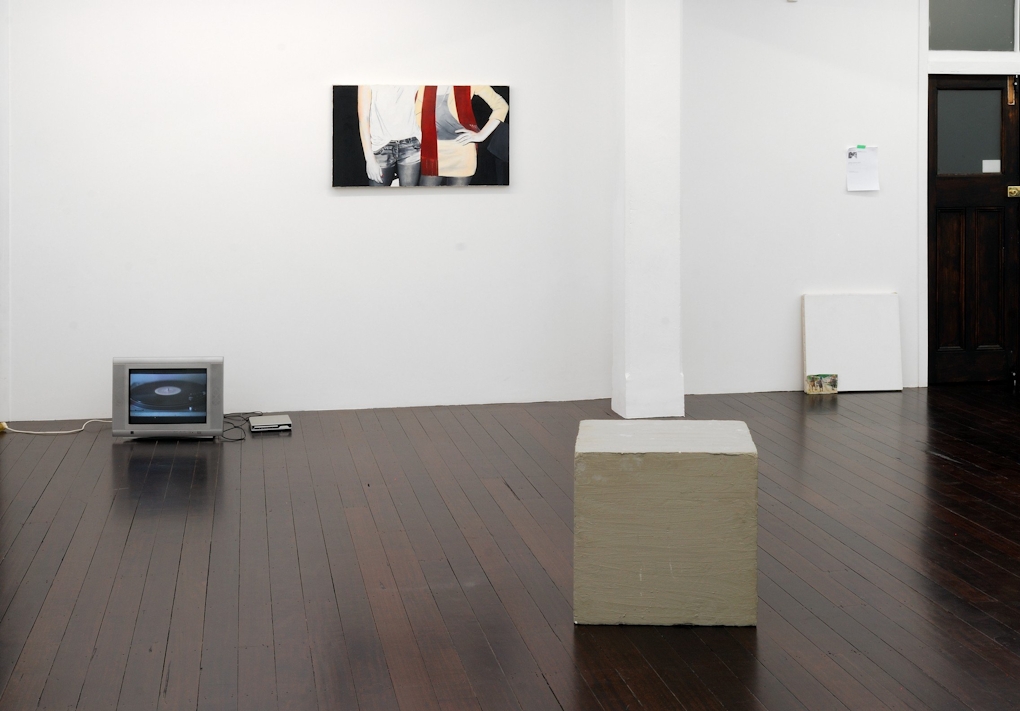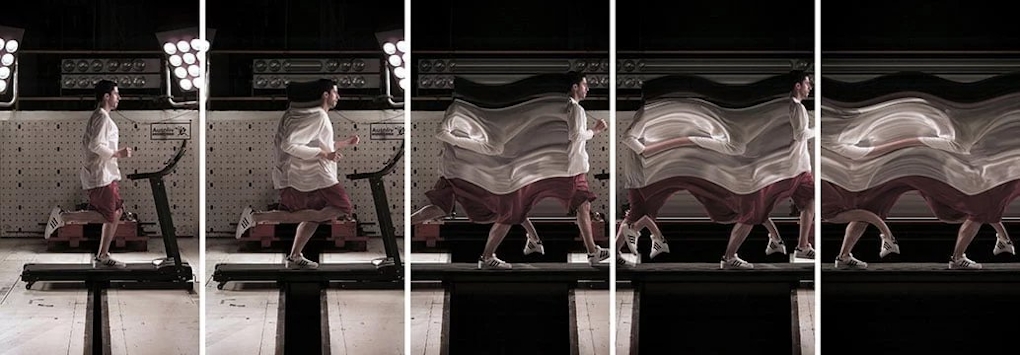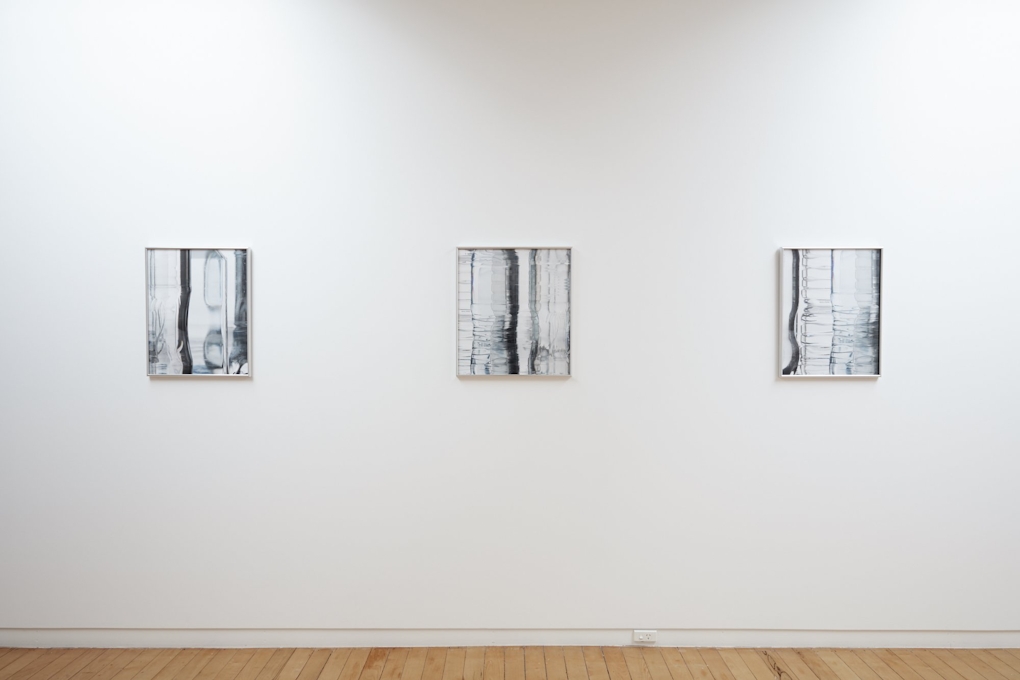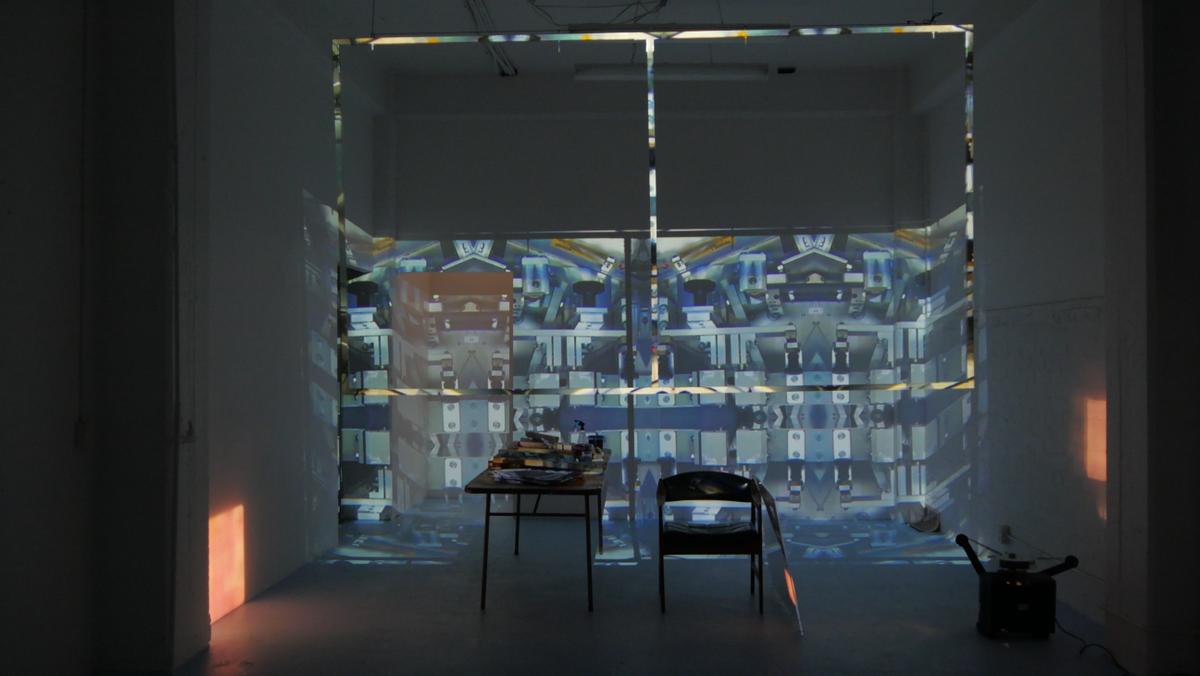Let’s start with what refraction is not. Refraction is not simply a reflection of what we want to be. We only need look at Baudrillard’s paroxysm of despair when facing the simulacrum of Disneyland to see where reflection ultimately ends. Or turn instead to Ruth Buchanan’s stuttering “I”s in her last show at Hopkinson Mossman to see the residual fear of pure reflection as it is coded under the auspices of reproductive fallacies. We need only remember too that Buchanan’s last show at The Adam(1) was written under the dictate of Harraway’s maximum that the self is a bad visual sign, an explication that renders mere reflection as the momentary embodiment of a contingent multiple at best.
In an age of drift, in which signs and selves slip indeterminately and freely between roles, pure reflection, with its paroxysm deadening in the copy no longer simply cuts it. Reflection under these conditions ends in the despair of a falsely slackened autonomy, a posturing of abject surrender to the impossibility of a narcissism we don’t need. Let’s turn then not to reflection, but refraction, that bending of light through mirrors so that what we get isn’t the straight take but the oblique angle, the refracting line in which storylines can multiply. Which of course is perfectly pitched for moving image’s mobilisation of the narrative. Recall the recent exhibition at play_station(2) in which Guillaume Gailleau gave us a chaotic representation of the forgery, of the copyist, whose very apparatus was split into vexatious narrative that refused to fall into any one frame. Indeed was that very projection of the film not passed literally through a kind of sieve. Moreover, the whole fervour of the exhibition, its caustic mood lighting, its intent mechanised soundtrack, surely that pointed not to the simple mechanised tedium of replication, but instead to that insidious desire to subvert, or manipulate a system. Small wonder then, that the projection evaded the set-up, refusing its capture in any one stream, but instead multiplying almost without heed.
Installation view of WUNDERSCHEIN (2019) Guillaume Cailleau, play_station gallery, 10–25 May 2019
Callieau’s exhibition is a complicated version of refraction. We can instead turn to the recently exhibited work of Luke Fowler to see how refraction works more simply to stitch together an autobiographical narrative that overlays its connections onto the linear format of film’s traditional tempo. It’s obvious then that we might think of refraction as belonging to that archival impulse that Hal Foster sees as so indicative of a contemporary art preoccupied with historical recuperation. It’s also clear then that we might think of Oscar Enberg’s Red Beryl (2017) as similarly a narrative of refraction, one that clearly takes advantage of moving images’ linear impulse to disrupt and reintroduce, to refract a narrative, that takes up disjuncture as an opportunity to make connections. Of course both Enberg’s and Gallieau’s use of refraction indulge in an almost paranoiac kind of connection, of a fervour of refraction, perhaps more so in Enberg where the narrative is stretched quite often to the point of a interruption and reduction. Such tactics do though function as a kind of noise, or static, a sort of background probe. This is perhaps most clear in Gallieau’s installation where that static infused a general atmosphere of distress as a kind of backdrop to the copyist’s fervour. We need only turn to Tahi Moore’s Nonsuch Park (2011), to see how generative this paranoiac suturing of a narrative might be.

Installation view of Nonsuch Park (2011) Hopkinson Cundy, Auckland
Refraction then is clearly a generative technique, especially when it comes to taking advantage of discontinuity or disjunction but it also offers other possibilities. Recall here, Daniel Crooks inclusion in the Wellington’s City Gallery exhibition Bullet Time (2016). Crook’s imagistic turn on cinema as a time-based medium could be a subject in itself, especially given the way his work so often becomes, to return to a phrase from my last diatribe, pictorial. This is helped little by the inclusion of Crooks in a show under the rubric of the slowed down montage sequence, the bullet time of the Matrix films (1999-2003), which so quickly turns to a kind of gag, something ably exploited by the Steve Carr films in the same show. Indeed Carr’s posturing, his rubber bands going onto the watermelon, or the balloons eventually popping all celebrated a kind of pictorialism that anticipates its own obvious solution. Crooks in this company comes to seem more and more representational rather than the obvious refractory elaborations one might expect from his mixing up of the time signature. And yet, even still, there is such a deliberate blurring of the representational strategy in Crooks that it’s hard to think of his films as being anything but refractory. Which of course they are but it’s a long way from the sorts of disjunction and discontinuity we see so keenly exploited by Gallieau or Enberg.

Static No.11 (man running) (2008) Daniel Crooks. Courtesy of the artist and Starkwhite
Perhaps then its better to look at what Crooks’ refractory technique inherits from cubism’s flattening of the picture plane. Did Braque and Picasso not deliberately flatten the representational surface so as to exaggerate the disjunction of cubism’s multiple perspectives. This flattening is similarly felt in Crooks’ video’s where the time signature stretches the traditional representational support of the moving image’s screen so that it becomes more absorbent than usual. Of course this flattening of the plane is what gives cubism its acute ability to refract, to distend the traditional image into other considerations. Perhaps then we might say that Crooks’ videos similarly alter the position from which we look, making it less the promontory vantage of traditional moving image work, that straight survey of a linear pictorialism, the more it is a mobile fissure, an opening up of the time signature to refractory possibilities. The trouble of course with Crooks’ work is how quickly the whole thing begins to look quite mannered, as though it just another version of a pictoralism we come to accept. Think how quickly Crooks’ blurring and overlaps of one image onto another come to see like so many stylisations rather than the rapid departures that interrogate the very mechanism of representation itself. Of course what it falls victim to is our readiness to accept these very techniques in cinema where motion is already a given; after all Benjamin long complained of our willingness to accept montage in film over cubism in painting.
We can look then to more recent photography by Shaun Waugh who has been splicing the imagistic tropes of the still life into refractory images that recall these lessons from cubism and its later updating in futurism. Based around the water bottle, a kind of béte noire of the contemporary tableaux, Waugh’s studies elaborate a multidimensional portrait of the banal in which two immediate subjects spring to mind. On the one hand there is the water bottle as exploitable detritus, as it is in the work of Bill Culbert. On the other, there are the representational strategies of the photograph. Of the two it’s worth first exploring what this agitation of photography’s presumed veracity really means.

Installation view of A Second Look (2018) Shaun Waugh. Courtesy the artist and Two Rooms. Photographer Sam Hartnett
Obviously, Waugh’s water bottle images owe a debt to the camera work of David Hockney who cobbled together those multi-shot assembles in the hope that he might develop a composite portrait that exceeds the superficial realism of photography’s representational maxim. How quickly though we return to the deadening paroxysm of the copy, of photography’s verisimilitude, that at least was Hockney’s gambit particularly given his status as painter, to turn in a kind of cubist photography that would validate his own sentimentalised form of painting as a refractory lens full of pathos. Waugh though, and it's why his photos are stripped of all colour is after no such thing, just a cool calculating mimicry of the machine. Indeed in exploiting photoshop’s composite processor, an algorithmic blending of multiple focal points commonly used in microscopy or macro-photography, Waugh’s arrangements purposely push this computational alertness to its edge. Blurring the very edge of the representational image by photographing the transparent water bottle onto a neutral background, Waugh deliberately flattens the representational plane and yet still forces the algorithm to pick up on the spherical qualities of the bottle. Much as it was in a cubist still life then the computer itself is forced to both flatten and yet refract the sensory deprivation forced upon it. This flattening though is of course a ruse on the part of the artist to compel the viewer to take up an active delectation, so that the viewer is less passive than when faced with an absorbent or pictorial image in which the narrative is all so obvious.
Waugh’s arrangements purposely push this computational alertness to its edge.
Clearly then Waugh is processing the still life in a similar manner to the cubist’s distillation of the tableaux so that it might refract something of its objective solidity as much as its purely pictorial representation. Perhaps though we might also think of Waugh’s use of the computer as inheriting the mannerisms of futurism’s dalliance with the machine, even perhaps as an accelerationist rhetoric of an advanced capitalism, dead-stopped as that reading would be on the plastic water bottle as exemplar sign of a disposable commodity culture. Both readings would explain the preternatural look of his photographs, which rely so much on their minute detail to develop that sheen of machinic realism, of a slicked up passage into hyper realism. This exposure though has been felt before in the photo-realist paintings of John Bader or Richard Estes, where the hyper realism of the image supersedes the actual pictorialism of the work itself. However if such heightened representations recall the copyist dramaturge of a script resolving itself, as it does in the sculpture of Ron Mueck, then what we see in Waugh’s photos is the hybridisation of human representation with technology. Not that the paintbrush has never been a technology but there is ready willingness in Waugh’s practice to give over to the camera, to give over the directorial impulse to the arbitrary conceits of the technology itself. Whether that’s described as a camera-less photography or a black box studio, the camera, in Waugh’s work is always better thought of as a background noise, a processor of information as much as the information itself. This is clearly evident in the refractory photographs of the bottles which rely entirely on the camera’s flattening of the plane, and the algorithms ability to piece it back together. That this technique would generate a cubist still life is less anachronistic throw back the more it is a continued demonstration of the relevance of refraction, a technique that clearly crosses the medium barriers in more ways than one.
